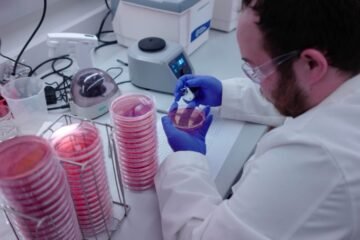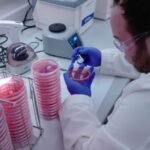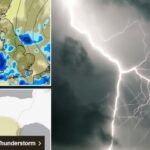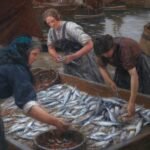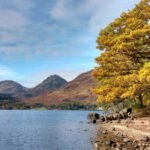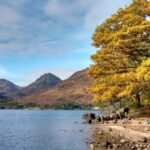When a photo of powder-white sand beside turquoise seas starts making the rounds on social media, the assumption is instant: Caribbean. Maldives. Maybe the Greek isles.
But Scotland?
Surprise—it’s not a Photoshop trick. It’s Tiree. Or Harris. Or the beaches of Lewis, where Atlantic winds kiss sugar-soft shores, and the sea is so clear you can spot starfish 20 meters below. Scotland, long stereotyped as grey and rain-soaked, is quietly hosting a tropical illusion—one forged by ocean science, geography, and light.
A Warm Ocean Current with a Tropical Agenda
The illusion begins 4,000 miles away in the balmy waters of the Caribbean. That’s where the Gulf Stream, a powerful Atlantic current, starts its long journey toward Europe—delivering a watery warmth that fundamentally reshapes Scotland’s coastal climate.
The stream pours around 30 million cubic meters of warm water per second into the Atlantic basin. By the time it wraps Scotland’s western shores, it’s already transforming ecosystems and creating rare marine environments well above their expected latitude.
“We’re seeing tropical fish species setting up residence in waters that by all logic should be far too cold,” says Dr. Sarah MacLeod, a marine biologist based in Oban. “The Gulf Stream is essentially warming up a cold country’s edges, turning Hebridean beaches into unexpected ecological jewels.”

Sun-Kissed Shores in the Land of Fog
Nowhere is this more visible than on Tiree, dubbed “Scotland’s Hawaii” by locals. The island receives 1,500 hours of sunshine per year, outshining even London. Add steady surf breaks and 20°C water in peak summer, and you’ve got a paradise where international surfing championships take place alongside sheep pastures.
But it’s not just Tiree. Harris and Lewis, the twin jewels of the Outer Hebrides, are dotted with beaches that could rival Seychelles—if you can get there.
And that’s part of the magic: remoteness. No all-inclusive resorts. No cruise port crowds. Just wind, water, and vast, silent bays.
What Makes These Waters So Clear?
Scotland’s “hidden Caribbean” isn’t a fluke. It’s the result of three converging natural factors:
1. Deep, Undisturbed Atlantic Waters
Unlike mainland beaches near cities or estuaries, the Outer Hebrides sit far from major rivers, meaning there’s no sediment-laden runoff. The surrounding Atlantic is clean, salty, and cold, which not only preserves water clarity but also allows sunlight to penetrate deeply. Visibility of 20 meters or more is common in places like Luskentyre or Seilebost—on par with premium dive sites in Belize or Tahiti.
2. Shelter from Extremes
The islands are in a geographic Goldilocks zone—sheltered from the full wrath of Arctic storms by their orientation, yet still bathed in the Gulf Stream’s warmth. The prevailing westerlies, already warmed by their transatlantic journey, can raise air temperatures 5–8°C higher than the Scottish mainland just across the sea.
Yes, palm trees do grow in western Scotland. No, it’s not a gimmick.
3. Summer Light That Lasts Forever
In July, some islands enjoy 18+ hours of daylight—a gift of northern latitude that floods beaches with usable light from 4 a.m. to nearly 11 p.m. The light, combined with water that holds warmth through the day, creates endless golden hours, perfect for photography, diving, or simply lying in the sand wondering how this is still the UK.
When to Go: Timing Your Scottish Tropics
The ideal months? May to September, with July and August offering the best chance at that tropical blend of warmth, calm seas, and extended daylight.
But remember: this isn’t Cancun. Scottish weather remains unpredictable, and a hot day can shift to drizzle in minutes. That’s why even seasoned travelers recommend layered packing—swimwear beside thermals and a windbreaker.
You’ll also want water shoes for rocky approaches, and reef-safe sunscreen to help preserve the fragile ecosystems now adapting to their warmed-up environment.
Why Solitude Might Be the Biggest Luxury
You could fly to the Caribbean, sure. But even its most beautiful beaches host thousands of visitors daily, with cruise ships docking and taxis swarming.
In contrast, on Harris, it’s entirely possible to walk for an hour without seeing another soul.
“The first time I visited Seilebost Beach, I thought I’d taken a wrong turn,” said travel photographer Isla Cameron. “It was vast, shimmering blue, and completely empty. I cried.”
That solitude, paired with a sensory cocktail of salty air, sun-warmed stones, and bird calls, gives these beaches an almost sacred feel. It’s not manufactured luxury—it’s raw, uncurated nature.
Sustainable Paradise: Protecting What Feels Untouched
With climate change warming waters globally, the ecosystems of Scotland’s west coast are becoming more sensitive. Tourism is rising, but so is awareness.
Local councils and private operators now emphasize:
-
Eco-conscious stays: Choose guesthouses and hotels that reduce energy use and protect native flora.
-
Minimal-impact exploration: Stick to marked paths and avoid disturbing sand dunes and nesting grounds.
-
Waste-free visits: Take out everything you bring in. And if you find washed-up plastics, carry those out too.
Dr. MacLeod urges visitors to think long-term: “The very things making these beaches extraordinary—clarity, warmth, wildlife—are fragile. We have a chance to protect them while they’re still rare.”


